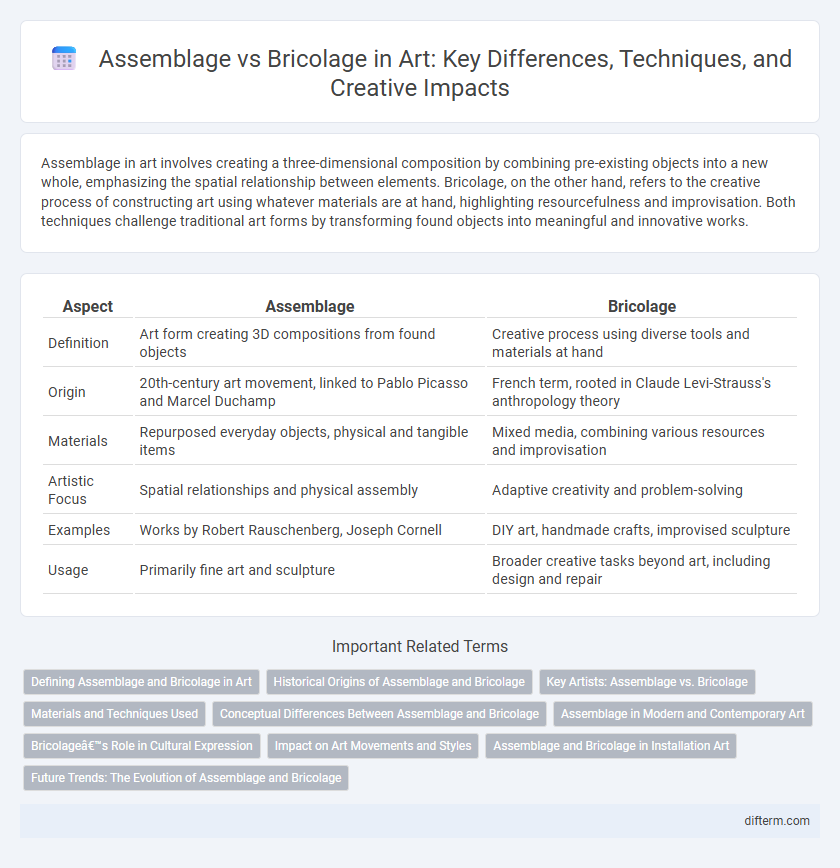Assemblage in art involves creating a three-dimensional composition by combining pre-existing objects into a new whole, emphasizing the spatial relationship between elements. Bricolage, on the other hand, refers to the creative process of constructing art using whatever materials are at hand, highlighting resourcefulness and improvisation. Both techniques challenge traditional art forms by transforming found objects into meaningful and innovative works.
Table of Comparison
| Aspect | Assemblage | Bricolage |
|---|---|---|
| Definition | Art form creating 3D compositions from found objects | Creative process using diverse tools and materials at hand |
| Origin | 20th-century art movement, linked to Pablo Picasso and Marcel Duchamp | French term, rooted in Claude Levi-Strauss's anthropology theory |
| Materials | Repurposed everyday objects, physical and tangible items | Mixed media, combining various resources and improvisation |
| Artistic Focus | Spatial relationships and physical assembly | Adaptive creativity and problem-solving |
| Examples | Works by Robert Rauschenberg, Joseph Cornell | DIY art, handmade crafts, improvised sculpture |
| Usage | Primarily fine art and sculpture | Broader creative tasks beyond art, including design and repair |
Defining Assemblage and Bricolage in Art
Assemblage in art refers to the technique of creating three-dimensional compositions by assembling found objects, often emphasizing the juxtaposition of disparate materials to produce new meanings. Bricolage involves constructing artwork using a diverse range of available materials and tools, highlighting creativity through resourcefulness and improvisation. Both assemblage and bricolage challenge traditional artistic boundaries by repurposing everyday objects, but assemblage centers on object accumulation, while bricolage emphasizes adaptive construction processes.
Historical Origins of Assemblage and Bricolage
Assemblage and bricolage both emerged as innovative artistic practices in the 20th century, with assemblage tracing its origins to Pablo Picasso and Georges Braque's Cubist experiments, where found objects were integrated into two-dimensional works. Bricolage, rooted in Claude Levi-Strauss's anthropological framework, refers to creating meaning by repurposing available materials and has been embraced in art as a method of constructing new narratives from existing cultural artifacts. The historical development of assemblage emphasizes the physical incorporation of diverse items, whereas bricolage highlights a conceptual reassembly, reflecting different approaches to materials and meaning in modern and contemporary art.
Key Artists: Assemblage vs. Bricolage
Key artists in assemblage include Robert Rauschenberg, whose "Combines" integrate found objects into painting, and Louise Nevelson, known for her monochromatic wooden sculptures. In bricolage, Jean Dubuffet exemplifies the approach by reusing everyday materials to challenge traditional art forms, while Pablo Picasso incorporated bricolage techniques in his collage work. Both assemblage and bricolage emphasize the creative reuse of materials, but assemblage often focuses on three-dimensional construction, whereas bricolage involves more spontaneous, improvisational composition.
Materials and Techniques Used
Assemblage art involves creating three-dimensional compositions by assembling found objects, often combining metal, wood, paper, and everyday materials through techniques such as welding, gluing, or nailing. Bricolage emphasizes improvisation using whatever materials are at hand, frequently incorporating fabric, wire, paper, and recycled elements, typically manipulated through cutting, layering, and simple construction methods. Both techniques transform ordinary materials into complex visual narratives by exploiting texture, form, and spatial relationships.
Conceptual Differences Between Assemblage and Bricolage
Assemblage involves creating artwork by assembling pre-existing objects into a cohesive whole, emphasizing the physical combination and spatial relationships between materials. Bricolage refers to the creative process of making art using whatever materials are readily available, highlighting improvisation and resourcefulness rather than planned construction. The conceptual difference lies in assemblage's focus on deliberate object selection and arrangement, whereas bricolage centers on adaptability and the re-purposing of found elements in an impromptu manner.
Assemblage in Modern and Contemporary Art
Assemblage in modern and contemporary art involves creating three-dimensional compositions by combining found objects and materials, emphasizing spatial relationships and materiality. Artists like Robert Rauschenberg and Louise Nevelson pioneered assemblage to challenge traditional art forms and explore new meanings through everyday objects. This technique contrasts with bricolage by focusing more on the art object's physical integration rather than solely its conceptual recombination.
Bricolage’s Role in Cultural Expression
Bricolage plays a crucial role in cultural expression by reusing available materials to create artworks that reflect diverse identities and histories. This process highlights an artist's resourcefulness and ability to transform everyday objects into meaningful cultural narratives. Unlike assemblage, which often emphasizes composition and aesthetics, bricolage foregrounds the significance of lived experience and cultural context through its adaptive and integrative approach.
Impact on Art Movements and Styles
Assemblage and bricolage significantly influenced modern and contemporary art movements by redefining material use and artistic processes. Assemblage, prominent in Dada and Surrealism, introduced three-dimensionality through found objects, shaping styles like Pop Art and Neo-Dada with its emphasis on everyday materials. Bricolage, rooted in postmodern theory, fostered eclectic and hybrid artworks, impacting movements such as Punk Art and Postmodernism by encouraging resourceful, context-driven creativity.
Assemblage and Bricolage in Installation Art
Assemblage in installation art involves the deliberate combination of found objects to create a cohesive three-dimensional work that conveys specific artistic concepts. Bricolage utilizes a similar approach but emphasizes improvisation and repurposing materials in a spontaneous, resourceful manner, often reflecting cultural or social narratives. Both techniques challenge traditional art boundaries by integrating everyday items into immersive environments, enriching the interpretive experience.
Future Trends: The Evolution of Assemblage and Bricolage
Future trends in assemblage and bricolage emphasize the fusion of digital and physical mediums, with artists integrating augmented reality and 3D printing to expand creative boundaries. Sustainable materials and recycled objects continue to shape the evolution of these art forms, reflecting environmental consciousness in contemporary practice. The growing prominence of interdisciplinary collaboration accelerates innovation, blending technology, craft, and traditional assemblage techniques.
assemblage vs bricolage Infographic

 difterm.com
difterm.com